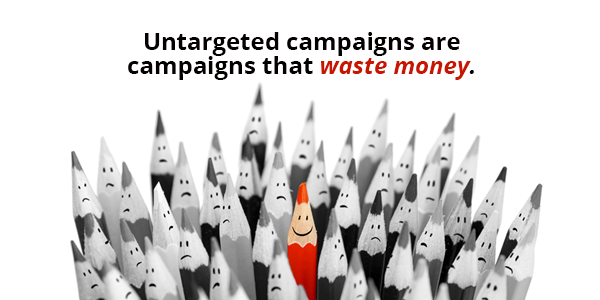“If you build it, they will come.” Or so says some baseball movie that everyone seems to quote.
The problem is that it’s not exactly true. At least not when it comes to marketing. Audiences today are more inundated than ever with marketing messages, new businesses and brands, and more tools that promise privacy, security, productivity, ease, and efficiency.
Building “it” doesn’t mean anything if no one knows “it” exists in the first place.
Enter the brand awareness campaign. Your quest is to put your brand name in front of as many relevant users as possible. That means not spending millions on a billboard when you have no idea who’s going to read it. Untargeted campaigns are campaigns that waste money.

So how do you maximize the success of your brand awareness campaign? Here are the six steps you’ll need to take in order to make your campaign successful:
1. Know Who You’re Trying to Reach
Do yourself and your brand a favor: sit down and map out exactly who you’re trying to reach.
Campaigns with no targets are campaigns that fail. The problem with these campaigns? The marketers behind them don’t know who they should be talking to in the first place.
Do yourself and your brand a favor: sit down and map out exactly who you’re trying to reach. Go through your buyer personas with a fine-toothed comb: age, gender, location, salary, industry, and job title.
If you’re looking to talk to CTOs who work in retail in the state of Kansas, for example, you need to create messaging that CTOs in retail in the state of Kansas will appreciate. You don’t want to end up spending precious campaign dollars seeing your message go to marketing directors if they’re not the ones who are going to buy your product.
And don’t get crazy with buyer personas—no one needs to name these people or find out if they’re partial to Italian food…unless that’s part of your brand.
2. Figure Out Where They “Live” Online
After defining who you want to target, you have to figure out how to make sure they actually see your campaign.
Are they on LinkedIn regularly? Place ads or promote a post. Is there a forum or online group that they frequent? Get involved. Are there blogs that this type of person reads regularly? Contact the website to see if you can guest-write or have someone write about your brand on that blog.
Don’t advertise everywhere—Facebook et al.—if your audience isn’t there. You will waste money and messaging because you’re going to reach people who aren’t your audience.
3. Keep Your Budget in Mind
Only when you know your budget can you allocate dollars properly. Know how much money you have to spend before you start spending.
If you don’t have much money to spend, it’s time to start getting creative: what platform will put your brand in front of the most potential buyers within your target? Use the bulk of your promotional dollars there.
Are there platforms you can get on for free by guest writing? Use those platforms and get creative about getting that organic search done.
Maybe you sell data security software and you know your audience is on Twitter: Follow anyone who tweets the phrase “data security.” Then interact with them. There are lots of organic things that you can do to get your brand in front of your intended audience.
Have a huge budget? Don’t make it rain just yet: figure out where the bulk of your money should be spent, which is the platform your audience will typically be on. Use organic, creative approaches where you can. Why? Because you never know what carrot they’re actually going to follow.
4. Know What Success Means
How will you know your brand awareness campaign is successful? What are you trying to accomplish through this brand awareness? Is it just awareness? Do you want lead captures and email addresses? Do you want website visits?
If you’re only tracking awareness, your metrics or key performance indicators (KPIs) will likely be your content’s likes and follows, shares and retweets, or impressions and reach. If you want to push your audience through their buyer’s journey a bit more, establish that upfront.
What numbers do you need to see in order to know that you’ve done a good job? Figure that out now. In other words, don’t look at the data and determine your takeaways; determine your takeaways and then seek out the data that will match it. And don’t be afraid of failing. Retargeting is a necessity in marketing—no one gets it right the first time.
5. Push the Red Button
You’ve figured out your audience and where they live, you know what you have to spend and have allocated it accordingly, and you know what data you need in order to call this campaign a success.
All that’s left to do now is craft your messaging, push the big red button, and wait.
Congratulations! You put together a brand awareness campaign…and you did it the right way.
6. Don’t Forget to Track Your Results
Remember when I said that you can’t measure success unless you know what your yardstick looks like? Don’t forget to watch those measurements carefully. Look at the data that shows you whether or not you did well according to the KPIs you set up.
Did the LinkedIn campaign flop while the blog you guest-wrote came out on top? Time to invest more in guest writing.
Maybe you got more impressions from the LinkedIn campaign than views on the blog, but you spent more time on the LinkedIn campaign. Don’t forget to track the amount of time and effort each one took as a KPI as well. It’s how you’ll measure ROI in the future.
And remember: don’t be afraid to fail and then change things up. Retargeting is designed to let you learn from your data and make better ads the next time around.
Compile information, deploy, track. Compile better information from that campaign, deploy another one, track. That’s how excellent brand awareness happens.
